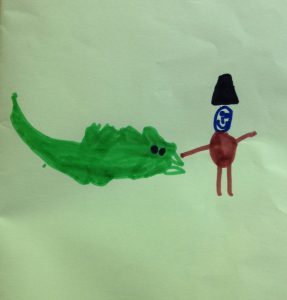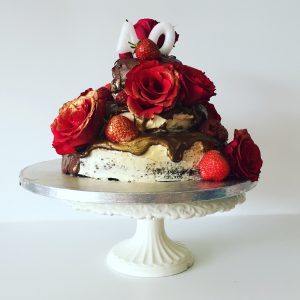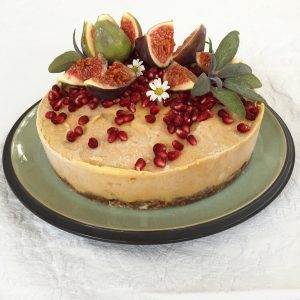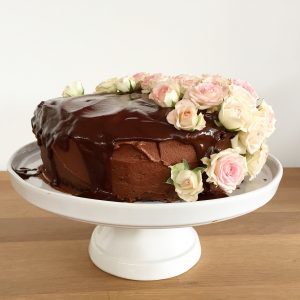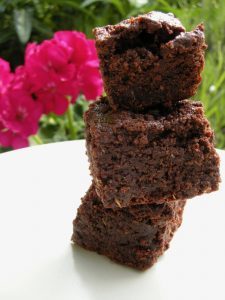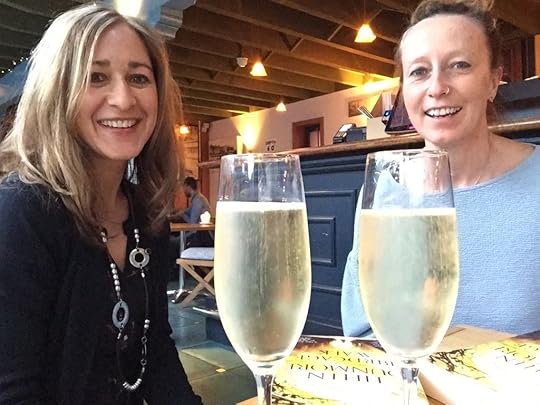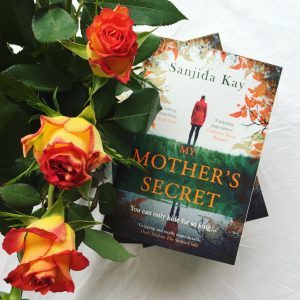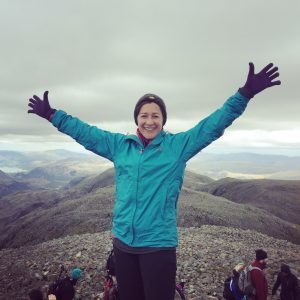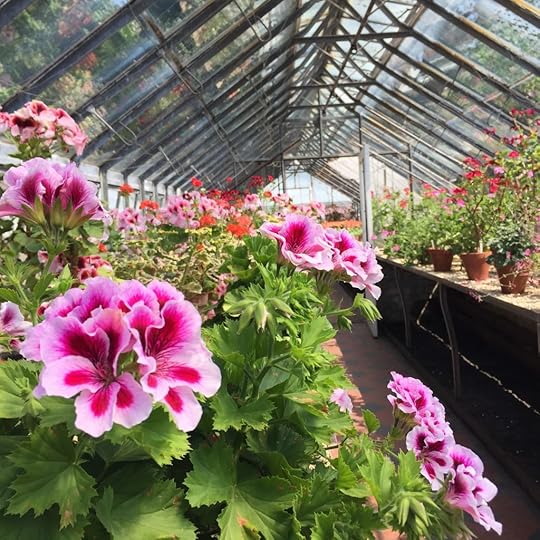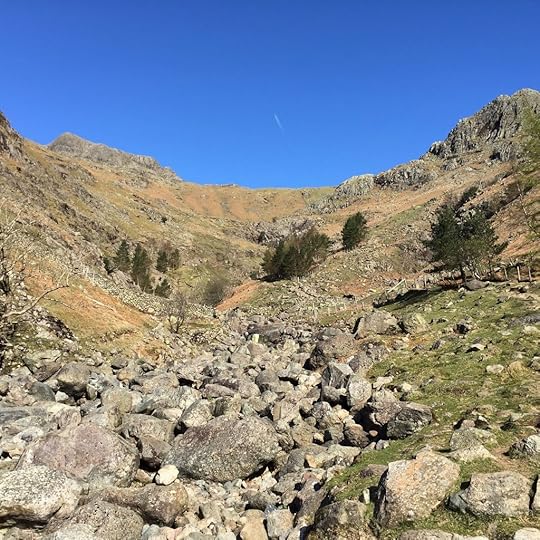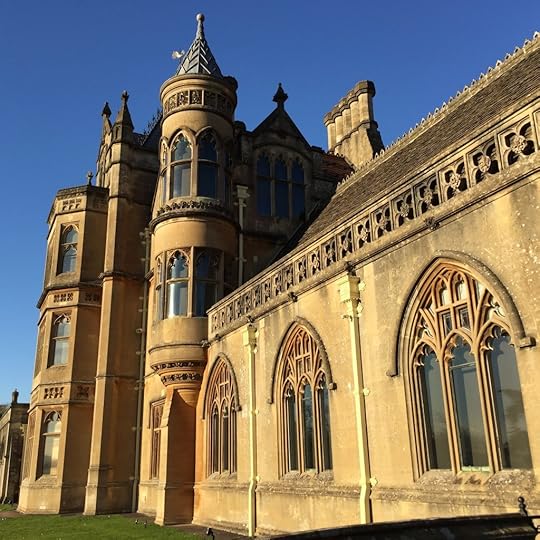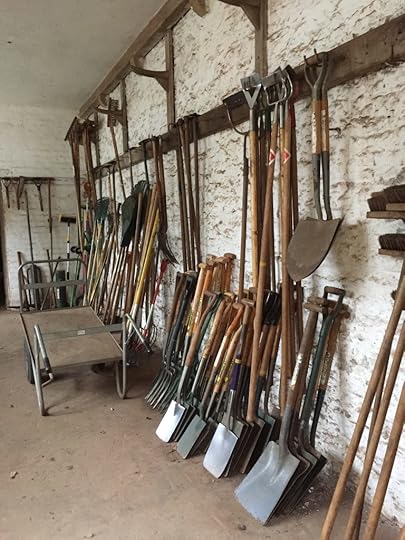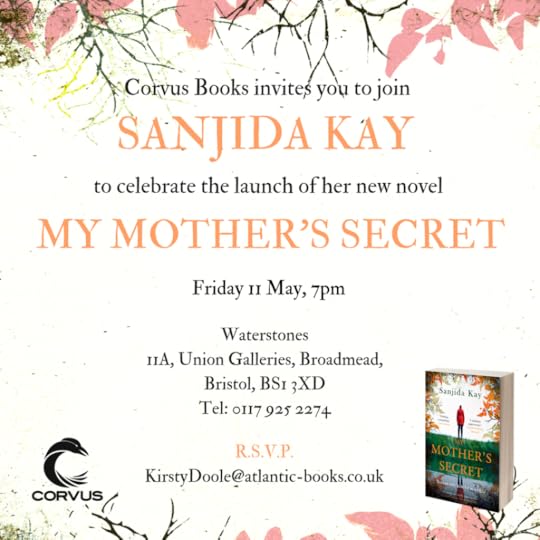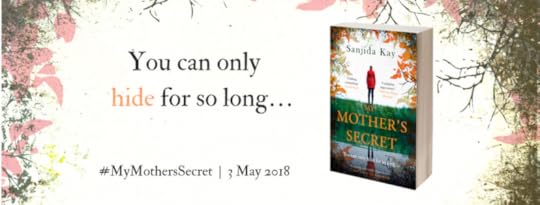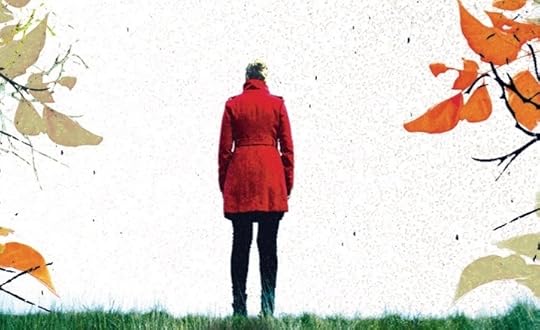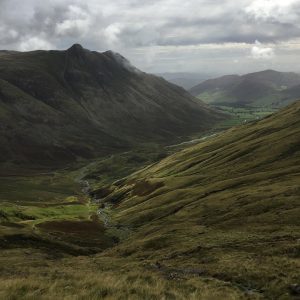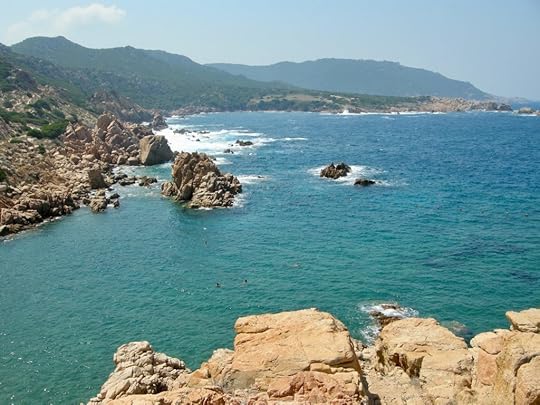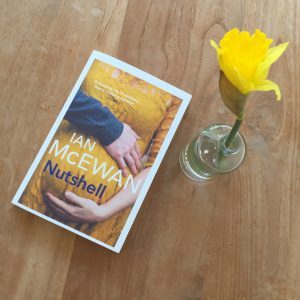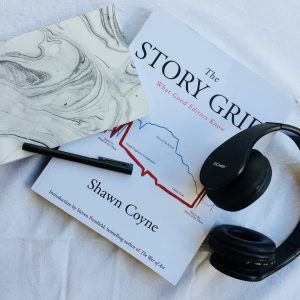Sanjida Kay's Blog, page 9
May 15, 2018
The octopus and the pirates
I’m giving a talk on plot at Novel Nights on Wednesday 23 Many. This is a wonderful monthly event, organised by writer, Grace Palmer, in Bristol. A writer talks about an aspect of their work, and local authors and aspiring writers read short extracts from their work-in-progress, all over a glass or two of wine.
If you happen to be in Bristol, do come along – the details are here. The full story, about how to plot, will be on the blog on Sunday 27 May.
In the meantime, here’s a sneak preview, inspired by a story my daughter wrote for me when she was four. Like most kids, she fascinated by dinosaurs and pirates. Now, if I could come up with a movie concept – Jurassic Park meets Pirates of the Caribbean – I’d be minted.
May 13, 2018
Cake!
There are 25 different kinds of cake name-checked in My Mother’s Secret, from Daim cake bought over the counter in Ikea, to scones with cream and jam, and lavender shortbread, served with Earl Grey from Tyntesfield’s National Trust tea shop, to chocolate-orange brownies and courgette cake decorated with a cream-cheese frosting and scattered with rose petals and rosemary flowers, made by my protagonist, Emma Taylor.
The chocolate cake doesn’t rise, so Harry and I rescue it by soaking it with an espresso-rum syrup and layering it in tiers with salted-caramel butter cream.
Emma Taylor
It’s an odd juxtaposition: cake and crime. Emma is a baker, working in Kate’s. Although she spends her days in what seems the most secure and seductively comforting of occupations – baking cakes and sourdough bread – Emma is anxious and nervous, hiding a terrible secret from her family and her friends. Whilst she rises around 4 a.m. to feed the yeast, her teenage daughter, Stella, is spying on her, determined to find out what her mother’s secret is. Meanwhile, a young student, Lizzie Bradshaw, out of her comfort zone in Leeds city centre, witnesses a shocking crime that will have repercussions for the rest of her life.
‘She doesn’t like alcohol in cakes. That’s Katie’s thing. And she isn’t into gluten-free or, you know, polenta. She doesn’t think it’s right for cake. Anyway, it’s what poor people eat.’ My dad winces, in spite of his best Dr Seuss face. ‘In developing countries like Mexico, I mean. You have to be middle-class to afford it here.’
Stella Taylor
The cakes – from the blackberry muffins, to the Black-forest gateau – are, of course, symbols of security, but in a thriller, nowhere, least of all the places where we live and work, are safe.
‘It sounds like something a pirate would eat.’
Paul Bradshaw
Whilst I was researching this novel, I had to delve into organised crime on the one hand, and on the other, hang out in a bakery (Hart’s Bakery in Bristol, which is the one Kate’s is based on) learning how to make croissants and discovering what on earth a friand is. Fortunately, I love baking anyhow so I found it a wonderful indulgence and a relief to write about cake in between the rather more chilling happenings in My Mother’s Secret.
‘She’d like a Victoria sponge with lots of cream and some fruit. Raspberries and jam. Something simple.’
He looks disappointed. I can see he wanted a statement of a cake. Like his love.
Stella Taylor
Unlike Emma, though, I don’t eat gluten and try not to consume sugar, so cake, in my real life, is an infrequent treat, usually made with polenta or gluten-free flour and sweetened with dates. Emma would not approve.
What are your favourite cakes? Do you have any favourites in My Mother’s Secret?
Thank you to Steph Rothwell, you first published this blog.
May 6, 2018
Book Club Questions for My Mother’s Secret
I love reading and writing – obviously! And I then love meeting up with people to chat about what I’ve read, maybe over a glass of wine!
In case you’d like to talk about My Mother’s Secret in your book club, we’ve put together some questions to get you started. You can download them below. Do email me if you have any of your own, or have a look at a Q&A with me.
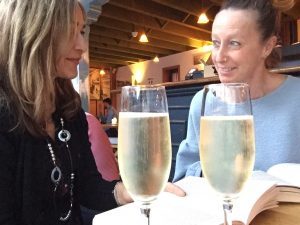 My Mother’s Secret Book Club Questions
My Mother’s Secret Book Club Questions
In the meantime, I’ll let you into a secret – the character I like best in My Mother’s Secret!
Do let me know who you like best!
May 4, 2018
My Mother’s Secret is out now!
My Mother’s Secret is out now! It’s available to buy in bookshops or from Amazon. You can read some extracts from it if you’d like to, or find out more about the book by downloading these links.
My Mother’s Secret – Chapters 1 & 2
The wonderful writer and the editor of the Asian Writer, Farhana Shaikh, interviewed me for her new podcast, Dear Writer. She had some lovely, sensitive questions and we discussed writing from fear, why I write thrillers, the link between nature and creativity and being British Asian.
And here’s a short interview with me talking about My Mother’s Secret.
Let me know what you think!
April 25, 2018
Win a free copy of My Mother’s Secret
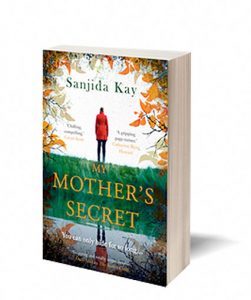 I’ve got ten free copies of My Mother’s Secret to give away! To enter the competition, please sign up to my newsletter (the sign up is to the right). The competition closes on the 3rd May and I’ll be selecting winners at random the following day.
I’ve got ten free copies of My Mother’s Secret to give away! To enter the competition, please sign up to my newsletter (the sign up is to the right). The competition closes on the 3rd May and I’ll be selecting winners at random the following day.
You can also sign up The Pigeonhole to win My Mother’s Secret, which will be serialised in ten extracts. The chance to win this competition ends on 3 May too.
Good luck!
April 22, 2018
Hiking for writing II
Happy Earth Day! Today, we’re celebrating our extraordinary planet, and trying to end plastic pollution.
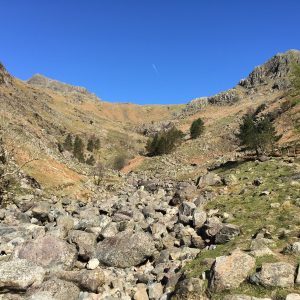 In a month I’ll be heading to one of my favourite places on earth, Langdale, in the Lake District, to go hiking and to talk about My Mother’s Secret in the Sticklebarn, a National Trust pub! I can’t imagine a more perfect combination: walking, wilderness, writing, reading, meeting old friends and new, and a cosy pub. Did I mention that my talk is in a pub? Oh, and the Sticklebarn brews it’s own gin and vodka!! (You can find the details here).
In a month I’ll be heading to one of my favourite places on earth, Langdale, in the Lake District, to go hiking and to talk about My Mother’s Secret in the Sticklebarn, a National Trust pub! I can’t imagine a more perfect combination: walking, wilderness, writing, reading, meeting old friends and new, and a cosy pub. Did I mention that my talk is in a pub? Oh, and the Sticklebarn brews it’s own gin and vodka!! (You can find the details here).
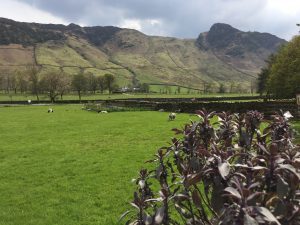 The view from the Sticklebarn
The view from the SticklebarnOne of the settings for My Mother’s Secret is Elterwater, near Langdale. I’ve been going for a few years and staying in the fantastic Elterwater Hostel. You can read more about my experience here, if you’re interested. So when I was wondering where my character, Lizzie Bradshaw, and her husband, Paul, could live, it seemed like a no-brainer. I imagined Paul working as a National Trust warden out on the Langdale Pikes (a spectacular set of mountains), and as a part-time barman in Sticklebarn. Obviously that meant I had to keep returning for further ‘research’!
The metal frame of their thirty-year-old backpack creaked as Paul adjusted the straps. She ran through their names in her mind: Pavey Ark, Thunacar Knott, Pike of Stickle, Loft Crag, Harrison Stickle – the five Langdale Pikes. If they even managed a couple of these hills, they’d be doing well.
They’d taken the path directly behind the back of the Sticklebarn pub, where Paul worked part-time at the weekends, past the gold blaze of larches in Raven Crag, and now they were heading along the ridge, with Dungeon Ghyll roaring below them.
I’ll be writing about using setting and location in fiction for the The Asian Writer, so do look out for that post.
I’ve written before about the joy of hiking for writing as I believe walking can help one be more creative. I’m not alone; many writers, from William Wordsworth to 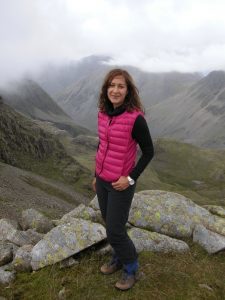 Charles Dickens, used walking to help them think about their work.
Charles Dickens, used walking to help them think about their work.
Recently, I came across some research by behaviour and learning psychologist, Marily Oppezzo, from Stanford University, on how walking can help trigger new ideas. Marily has run several studies on movement and creativity, but in one, she asked people to brainstorm how an everyday object, say a key, could be used creatively. The definition of creativity she used was that it had to be novel and appropriate, in other words, no one has come up with that idea before, but also, appropriate for the situation (so, we all know keys open locks – so another use for a key that is unusual but fitting). The people doing the test either sat down or they walked on a treadmill in a windowless room.
What her team found was that the people on the treadmill came up with twice as many ideas! As a result of her research, she’s come up with a few tips: she says to decide on a topic you want to brainstorm first, then go for a walk, think of as many ideas as you can, and jot them down at the time (either take a notebook or record them in your phone).
This is also how I work: I put a writing problem into my subconscious, and then later, I’ll go for a walk, take it out and turn it about. Big hikes with company are fantastic in a different way. I won’t necessarily be able to concentrate on knotty problems on the way up Thunacar Knott, but I will return refreshed and reinvigorated by the walk, the wildlife and my inspiring friend; ready to crack on with the next novel!
I do hope to see you in the Sticklebarn pub for a chat about writing, walking and, maybe, gin!
SaveSave
SaveSave
SaveSave
April 15, 2018
In praise of the National Trust
It’s perhaps no surprise that two of the settings in my third thriller, My Mother’s Secret, are based at National Trust sites. For me, the best part of being British is the National Trust. I love the fact that the charity preserves great swathes of our countryside (over 248,000 hectares), including parts of the Lake District, fens and forests, 775 miles of our coastline, as well as conserving nearly a million works of art and over 500 historic houses, castles and ancient monuments.
As a trained zoologist, what’s most important to me personally, is the investment in our wildlife. More than half of the species in this country are in decline and need help urgently. Peter Nixon, the National Trust’s Director of Land, Landscape and Nature, said, ’Birds such as the cuckoo, lapwing and curlew are part of the fabric of our rural heritage. But they’ve virtually disappeared from the countryside. We want to see them return to the fields, woods and meadows again, along with other wildlife which was once common and is now rare.’
I’m a keen walker, but not everyone can trek along our rocky Cornish coastline, or hike up Scafell; another aspect that I think is wonderful is how accessible the charity has made our heritage, whether you’re five or eighty-five. Plus the cakes in the tea rooms are pretty nice!
The spoken word flies away, the written word remains.
Inscription in Latin in Tyntesfield library
Many of the scenes in My Mother’s Secret are set at Tyntesfield, a gothic mansion and parkland just outside Bristol. Because I’m drawn to nature, I generally have some wildlife in my books (Paul Bradshaw’s son, Dylan, for instance, is helping Bristol University track foxes in Ashton Court), but also, as a thriller writer, I like the juxtaposition of urban and wilderness. As human beings, we’ve evolved to be frightened of being away from our tribe, of being on our own and in the dark in a forest or other wild place. Including these settings in a thriller feeds into the fear we feel when we read a tense passage, where the protagonist could be danger.
‘My voice bounces around the old stone walls, and the echoes make me even more scared. I’m crying properly now. How could he just go out and leave me? The pain drowns out my shame, just for a few moments. I take out my phone, but there’s no signal here. I’m starting to feel really frightened. I’m on my own in the dark, and no one knows where I am.’
Stella
I’m also interested in exploring what historic sites mean to us today: perhaps, as someone who is mixed-race, I feel this more acutely, but many were built using money from slavery. At the very least, the families that originally owned them, such as the Gibbs at Tyntesfield, inherited or made a fortune, whilst those less fortunate toiled in their fields or scrubbed their stairs for a pittance.
‘We drag our heels, going slower and slower, as the path winds steeply down through the ironically named Paradise, with its tree ferns and palms – all part of the Victorians’ plunder of Third World countries, to bring back rare stuff and show off. Everything is ornate. Even the benches are made of stone and carved with Tudor roses. All those poor people, chipping granite just to get some stale bread.’
Stella
However, I do think it’s important that these mansions and monuments are preserved, so that future generations understand where we came from and how many once lived – and that the surrounding estates and parklands are preserved to help our wildlife flourish.
If you’d like to see some more photos of the settings that inspired me, do have a look at my Pinterest board.
SaveSave
SaveSaveSaveSave
April 8, 2018
Party like a writer!
I’d love you to come to my book launch party if you can make it! It’s 7 p.m. Friday 11 May at Waterstones, Bristol. There’ll be readings from My Mother’s Secret, and since the lead character, Emma Taylor, is a baker, it’s only right and proper that we should have plenty of cake! There will also be fizz, beer and soft drinks to wash it down! It’s a free event, but do RSVP so we know how much cake to bake!
I will also be in Bath at Toppings & Co on Monday 14 May at 7.30 p.m.; discussing plot at Novel Nights on 23 May at 7.30 p.m. and reading in one of the locations featured in the novel – Sticklebarn, Langdale in the Lake District on 26 May. Please check my Events page for details.
If you’re interested in finding out a bit more about what inspired me, have a look at this mini video, or take a look at In Conversation with…
If you’d like to download a free sample of chapter one and two, told from Emma, and her daughter’s perspective, they’re here:
My Mother’s Secret – Chapters 1 & 2
My Mother’s Secret is available to pre-order.
SaveSave
April 2, 2018
In conversation with Sanjida Kay
It’s one month until my next thriller, My Mother’s Secret, is going to be published!
I thought I’d share a Q&A with you on what my novel is all about, where it’s set and the inspiration behind it. You can download it here, My Mother’s Secret Q&A or else read it in the blog below.
In the meantime, here’s a free sample: My Mother’s Secret – Prologue
If you are interested in reading further, it’s available to pre-order here.
So, Sanjida Kay, tell us what My Mother’s Secret is about.
My Mother’s Secret is told from the point of view of three women: Lizzie Bradshaw, Emma Taylor, and her teenage daughter, Stella. Stella thinks that her mother has a secret. She knows her mother had a traumatic childhood, and that she’s an unusually anxious person, who sometimes has panic attacks. But she believes her mother is hiding something bigger, and Stella is determined to find out what it is. As Emma tries to keep her secret, Lizzie is caught up in a terrible crime… and Stella’s investigations will uncover something truly shocking that could shatter all their lives…
I write, ‘My mother has a secret.’
What was the inspiration behind My Mother’s Secret?
It’s hard to say exactly what the inspiration was, because that would give away the secret Emma is hiding! There were a few stories in the news that obsessed me at the time. One of them was about undercover police officers who infiltrated environmental activist groups and had families with some of the women they were investigating. Although My Mother’s Secret is not about undercover cops, it made me think about longterm lies and deception within close relationships, whether you can ever truly know those you love dearly, as well as power imbalances within marriage.
…as you can see, my dear, I know who you are and where to find you…
The story is mainly set in Bristol, the Lake District and Leeds – with two National Trust estates featuring prominently! Setting is really important to you. Can you tell us a bit about the locations for My Mother’s Secret?
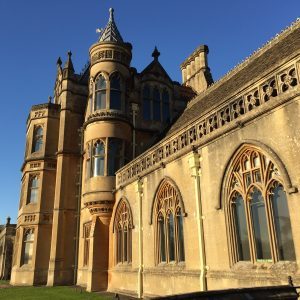 The settings in My Mother’s Secret are all dear to me. Emma and her husband, Jack, and their two daughters, Stella and Ava, live in a suburb of Bristol called Long Ashton. Emma frequently visits a ‘friend’ at Tyntesfield, which is a magnificent Gothic mansion owned by the National Trust, just outside Bristol. Stella says the house looks as if it was designed by ‘an architect on crack’; the estate was funded by the Gibbs’ family’s trade in guano. An episode of the BBC’s Sherlock Holmes was filmed there! Tyntesfield is surrounded by wonderful grounds and woods. I love visiting – and researching the novel was a brilliant excuse to go as often as possible!
The settings in My Mother’s Secret are all dear to me. Emma and her husband, Jack, and their two daughters, Stella and Ava, live in a suburb of Bristol called Long Ashton. Emma frequently visits a ‘friend’ at Tyntesfield, which is a magnificent Gothic mansion owned by the National Trust, just outside Bristol. Stella says the house looks as if it was designed by ‘an architect on crack’; the estate was funded by the Gibbs’ family’s trade in guano. An episode of the BBC’s Sherlock Holmes was filmed there! Tyntesfield is surrounded by wonderful grounds and woods. I love visiting – and researching the novel was a brilliant excuse to go as often as possible!
I can’t help shuddering. He means the large, curved metal cage in the courtyard near the servants’ entrance. It’s large enough for a child to stand inside and, like the aviary on the other side, reminds me of something sinister out of a fairy story.
Lizzie and her young family, Paul and baby Dylan, live in Elterwater, a hamlet in the Lake District. Whilst Lizzie is commuting to Leeds for her job, Paul is doing a double shift for the National Trust, as a part-time warden in a mountain range known as the Langdale Pikes, and as a bar man in the National Trust’s only pub: The Sticklebarn Inn. I love hiking, and visit the Lake District at least once a year. I normally stay in an amazing hostel in Elterwater; from there I can walk to one of my favourite mountains, Scafell Pike. And I normally manage to call in at the Sticklebarn Inn on the way back!
Apart from hanging out in National Trust tea shops and having mini breaks in the Lakes, what kind of research did you have to do for My Mother’s Secret?
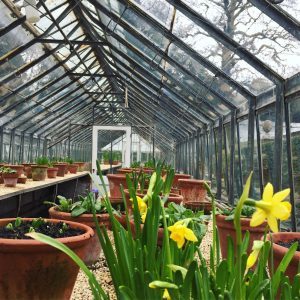 The life of an author is so tough! I had an odd juxtaposition with my research: Emma is a baker; she works in a bakery based on Hart’s Bakery, beneath Temple Meads station in Bristol. So I spent a day hanging out with the bakers, as well as visiting pretty frequently! I was totally able to indulge my cake obsession in this novel! The other aspect of my research, though, was investigating the impact of organised crime. From the sublime to the horrific.
The life of an author is so tough! I had an odd juxtaposition with my research: Emma is a baker; she works in a bakery based on Hart’s Bakery, beneath Temple Meads station in Bristol. So I spent a day hanging out with the bakers, as well as visiting pretty frequently! I was totally able to indulge my cake obsession in this novel! The other aspect of my research, though, was investigating the impact of organised crime. From the sublime to the horrific.
His words echo in my head: ‘I can assure you that, as well as killing you, I will hunt down your family and I will kill them, and then I will find your friends and I will kill them, too.’
Although My Mother’s Secret is a commercial thriller, you’ve included a few discussions on some literary fiction. Why is that?
Stella is in a Book Club at school. She’s a spiky, slightly tom-boyish girl, who loves Jane Eyre – and, of course, the Gothic element in the book fits in beautifully with the Gothic mansion at Tyntesfield. One of the books she’s reading in her book group is The Golden Bowl by Henry James. For anyone who knows me, they’ll know that I like to write books that can be read as straightforward stories, but there’s usually another element going on for anyone who is interested. In My Mother’s Secret, the theme is from this wonderful tale, by Henry James. When American heiress, Maggie Verver, is about to get married, her best friend and her fiancé, who happen to have been in a relationship with each other, buy her a wedding gift. It’s a golden bowl, but when they bring it home, they realise the bowl has a crack in it. It’s a metaphor, a symbol, and also a key that unlocks one of the novel’s revelations.
The book he was looking at has fallen open on a double-page spread. It’s a quote in exquisite calligraphy: ‘It isn’t a question of beauty, it’s only a question of truth.’
What are you working on at the moment?
I’m writing another psychological thriller for Corvus Books, provisionally called The Holiday. It’s about a family whose three-year-old daughter drowned a year ago. The mother, Amy, wants the whole, extended family to go away for the anniversary of her daughter’s death to try and heal. She books a house on a tiny island in Italy though an online company…but the holiday goes dangerously wrong. My inspiration for this one was the rise of online holiday companies, which might not always be the safest option for travellers…
I lean on the windowsill to look down at the swimming pool, and something sharp digs into my palm. I wince; embedded in the heel of my hand is a human tooth. It’s tiny with a sharp point, a dull ivory, with a hollow where it once grew in a child’s jaw.
Looking forward to hearing what you think!
SaveSave
SaveSave
SaveSaveSaveSaveSaveSave
SaveSaveSaveSaveSaveSave
SaveSaveSaveSave
SaveSave
March 25, 2018
Easter holiday reading recommendations
We’re coming up to the Easter holidays. My family had a lovely tradition when we were growing up: my mum would hide a book instead of a chocolate Easter egg for me…although I think there’d be a rebellion if I tried to do that in our house! I hope you enjoy some time to read over the holidays. Do let me know what you’re reading and what you think of these suggestions. Chocolate optional.
So here I am, upside down in a woman…
So begins Nutshell, narrated by a foetus who sounds like an erudite, arrogant, aristocrat. Nearly full term, and fuelled by podcasts and Sancerre, our exceptionally young man is concerned because his mother and her lover are about to do something terrible to his father.
Now I’m certain…they’re planning a dreadful event. Should it go wrong, I’ve heard them say, their lives will be ruined.
A combination of psychological thriller, treatise on modern malaise, ode to poetry and homage to Hamlet, this could be insufferable, but manages, instead to be wry, poignant, gripping as well as wonderfully written.
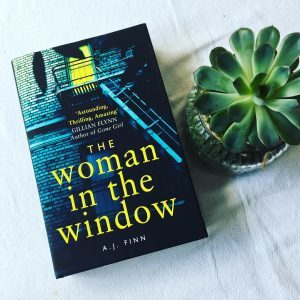 The Woman in the Window
by A.J. Finn
The Woman in the Window
by A.J. Finn
A domestic noir inspired by Hitchcock’s Rear View Window: psychologist Anna Fox has suffered some kind of trauma, which has left her agoraphobic and confined to her house in New York. She and her husband are separated, and he currently has their daughter, Olivia, with him. Anna spends her days playing chess online, counselling fellow agoraphobics and spying on her neighbours.
Some nights I haunt her room like a ghost. Some days I stand in the doorway, watch the slow traffic of dust motes in the sun. Some weeks I don’t visit the fourth floor at all, and it starts to melt into memory, like the feel of rain on my skin.
New neighbours move in who seem to be a mirror of the family she’s lost: a husband, wife and their teenage son. Then one day, Anna sees something terrible happen in their house but thanks to Anna’s cornucopia of medication, and merlot as medicine, no one believes her.
The ash tree cowers, the limestone glowers, dark and damp. I remember dropping a glass onto the patio once; it burst like a bubble, merlot flaring across the ground and flooding the veins of the stone work, dark and bloody, crawling towards my feet.
This is a beautifully written book, which starts gently before the stomach-clenching, jaw-dropping twists begin. The characters are brilliantly realised, the guilt, the fear and the claustrophobia are palpable.
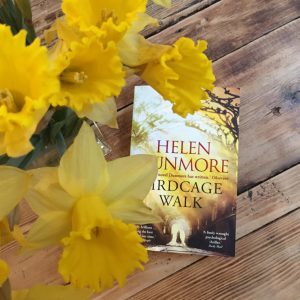 Birdcage Walk by Helen Dunmore
Birdcage Walk by Helen Dunmore
It’s 1792 and Europe is rocked by political violence whilst in Bristol there is a property boom, that will, as we know now, collapse barely a year later when war breaks out between England and France. Birdcage Walk is a psychological and historical thriller about Lizzie Fawkes, daughter of radical feminist, Julia Fawkes, who marries property developer, John Diner Tredevant. I loved the historical details, particularly as the novel is set in Bristol, where I have spent most of my adult life.
We gazed out at the plunge of the Gorge. From here we could not see the river crawling in its bed, but saw the dark curve of the trees on the other side. The forest was so thick that I never wanted to enter it. It seemed as if anything might live within it.
Although the backdrop of the novel is political and social, the characters are incredibly realistic, at its heart, it’s about the love between mother and daughter, and how Diner is threatened, not only by their relationship, but by Lizzie’s independent and questioning nature.
My irritation melted. No one, I thought suddenly, would ever look at me like that, except for Mammie, because to her every good thing, every moment of happiness that came to me meant more than if it came to herself.
We learn early on what manner of man Diner is; his desire to control and suppress Lizzie is claustrophobic. This is a beautifully written novel, laced with dread, and shot through with emotional depth and compassion.
Birdcage Walk is the last book Dunmore wrote before she died. She finished it before she realised how seriously ill she was, but it’s possible she knew subconsciously that she was failing, for this novel is suffused with darkness and loss. As she herself wrote, ‘The question of what is left behind by a life haunts the novel.’
Watching
Shetland based on Anne Cleeves’ Jimmy Perez detective novels: gripping, touching and emotionally raw; and thriller, McMafia, a taut, family-based drama, of one man’s road to ruin, inspired by Misha Glenny’s non-fiction account of international crime.
Story Grid Podcast based on Shawn Coyne’s book on how to develop one’s craft as a writer; with aspiring novelist, Tim Grahl. An absolute must-read/listen if you want to be a fantastic fiction writer!
SaveSave
SaveSaveSaveSave
SaveSave
SaveSave
SaveSave
SaveSave

